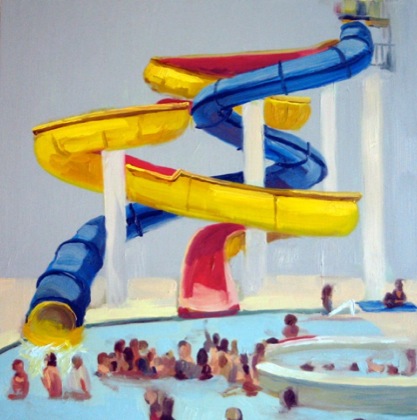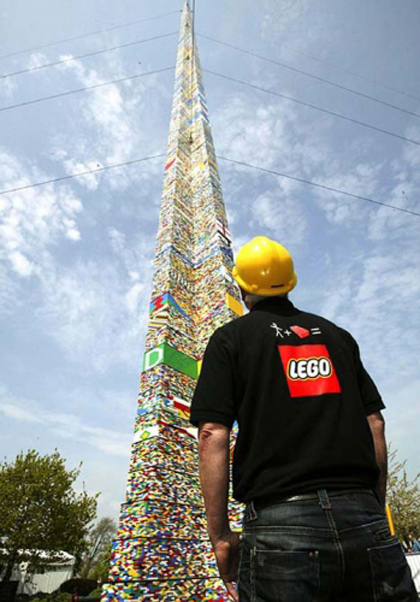Posts tagged play
 Best. Toys. Ever?
Best. Toys. Ever?
When I was a kid one of my favorite things to play with was Dirt. At some point I picked up an interest in cleanliness and I have to admit that I’m personally not such a fan of Dirt anymore—many parents (particularly indoor people like me) aren’t so fond if it either. But you can’t argue with success. Dirt has been around longer than any of the other toys on this list, and shows no signs of going away. There’s just no getting rid of it, so you might as well learn to live with it.
First off, playing with Dirt is actually good for you. It’s even sort of edible (in the way that Play-doh and crayons are edible). But some studies have shown that kids who play with Dirt have stronger immune systems than those who don’t. So even if it means doing some more laundry (Dirt is notorious for the stains it causes) it might be worth getting your kids some Dirt.
So what can you do with Dirt? Well, it’s great for digging and piling and making piles. We’ve got a number of outdoor toys in our backyard, but my kids spend most of their time outside just playing with Dirt. Use it with Stick as a large-format ephemeral art form. (didn’t I tell you how versatile Stick was?) Dirt makes a great play surface for toy trucks and cars. Need something a little gloopier? Just add water and—presto!—you’ve got Mud!
 It creates no wealth or goods
It creates no wealth or goods
A characteristic of play, in fact, is that it creates no wealth or goods, thus differing from work or art. At the end of the game, all can and must start over again at the same point. Nothing has been harvested or manufactured, no masterpiece has been created, no capital has accrued. Play is an occasion of pure waste: waste of time, energy, ingenuity, skill, and often of money ... As for the professionals—the boxers, cyclists, jockeys, or actors who earn their living in the ring, track, or hippodrome or on the stage, and who must think in terms of prize, salary, or title—it is clear that they are not players but workers. When they play it is at some other game.
 Play more
Play more
Children overwhelmingly prefer playing with their friends and parents over watching TV.
When children across the world were asked to choose between watching TV or playing with friends or parents, they overwhelmingly choose to play with friends (89%) and parents (73%) with TV a very poor substitute for social interaction at only 11%.
Nearly half of the parents think play should be educational. Children disagree.
Nearly half (45%) of all parents think that play is best when it’s educational. This rises to two thirds of parents in China, Slovakia, Czech Rep, Spain, Hungary, Russia, Poland and Portugal. A further minority at 17% (China, Italy, Russia and US) actually prefer their children to learn things rather than to simply play. 27% think play should always have a purpose. As for the children, 51% actually prefer to play rather than learn.
 The private languages of Lego
The private languages of Lego
Then, when another seven-year-old came round for tea after school one day, I overheard the two of them, busy in the spaceship construction yard that used to be our living room, get into a linguistic thicket.
“Can you see any clippy bits?” my son asked his friend. The friend was flummoxed. “Do you mean handy bits?” he asked, pointing.
“Yes,” replied my boy. “Clippy bits.”
Of course! This language of Lego isn’t just something our family has invented; every Lego-building family must have its own vocabulary. And the words they use (mostly invented by the children, not the adults) are likely to be different every time. But how different? And what sort of words?
 Kindergarten stress
Kindergarten stress
[Testing] neither predicts nor improves young children’s educational outcomes. More disturbing, along with other academic demands, like assigning homework to 5-year-olds, it is crowding out the one thing that truly is vital to their future success: play.
A survey of 254 teachers in New York and Los Angeles the group commissioned found that kindergartners spent two to three hours a day being instructed and tested in reading and math. They spent less than 30 minutes playing. “Play at age 5 is of great importance not just to intellectual but emotional, psychological social and spiritual development,” says Edward Miller, the report’s co-author. Play — especially the let’s-pretend, dramatic sort — is how kids develop higher-level thinking, hone their language and social skills, cultivate empathy. It also reduces stress, and that’s a word that should not have to be used in the same sentence as “kindergartner” in the first place.
 From gardening to gaming
From gardening to gaming
One day Miyamoto was tending his garden. He was in awe at the process of planting, growing and harvesting and the general admiration of the beauty that can arise out of the garden. This is when the crazy idea of making some sort of garden-influenced game came to mind. As cheesy and boring as it may sound, he did not end up with a design reminiscent of literally watching grass grow on your TV screen. The end result was Pikmin, a title where the player plants and harvests little flower creatures. You play as Captain Olimar whose job is to keep all the Pikmin alive, safe from the large bugs and animals that inhabit the planet. Quite a far cry from the shoot-to-kill mentality, eh?
A few years after bringing an evolved sense of gardening to gaming, Miyamoto oversaw the advent of Wii Fit, a new interactive way to bring health into the fold of non-traditional gaming. So instead of playing a version of creation on screen, the player would literally be working out, which in and of itself isn’t new or innovative, but bringing it into the fold of interactive games is more than admirable. Even the joy of playing music is made simpler, a-la Guitar Hero or Rock Band, in Wii Music - a simpler way to enjoy the beauty of making music than even the aforementioned blockbusters.
 Tower of Lego Babel
Tower of Lego Babel






